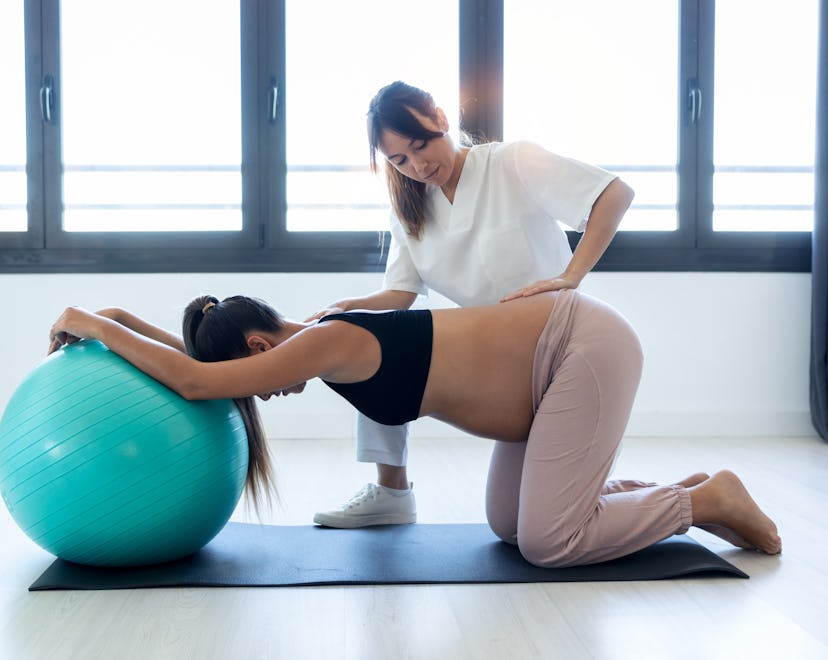Labor & Delivery

6 Doula-Recommended Labor Positions To Get Through Contractions
Some may seem weird, but your body will thank you!
Contractions have a way of bringing the laboring mom-to-be’s mind sharply in focus. And the single, emphatic thought going through her head will be how to get past the pain. There are some doula-recommended labor positions that help you get through contractions.
Labor contractions are the tightening and relaxing of the muscles of the uterus, the baby’s months-long home in your body. These involuntary muscle movements do several things at once: move the baby down toward your cervix, thin the cervix (called effacing) and stretch it open (dilating). Contractions are literally preparing your body to safely allow something the size of a mini watermelon to get through an opening that when fully dilated is about the size of a doughnut.
Many first-time mothers-to-be are anxious about labor and the pain it causes. To soothe your fears it helps to become familiar with the best labor positions to get through contractions and move the birthing process along. We asked a couple of certified birth and postpartum doulas to advise us on some of their recommended positions to get you through the tough moments. When it’s go-time, sensations may shift quickly, so don’t be afraid to try all of these positions as each may provide relief at different times.
If you’re getting close to your due date, there’s one activity you can start now. “Walking helps get the body prepared for labor,” says Talena Cawthon, certified birth and postpartum doula. “The motion of your hips wiggles the baby down.”
Labor Positions That Help With Contractions
Deep Squats
Getting vertical moves your spine out of the way of the contraction’s path through your body. “Squats open up the pelvis to allow your baby to descend. They create pressure on the cervix which encourages dilation,” says Samantha Greiner, birth and postpartum doula, in an interview with Romper.
Cawthon adds that this is her favorite position for moms to use because while it helps press your baby down it also, “takes the pressure off the lower back.”
Sit On A Birth Ball
If squatting is hard on your legs, try sitting. “Sitting on a birth ball helps bounce the baby into the pelvis, and rotating on the ball helps rock baby down,” Cawthon tells Romper.
Sit On The Toilet
Cawthon says this may seem like a strange one, but it works similarly to the other squatting positions. “It might be weird, but the gravity really helps baby move along.”
Resting Position Between Contractions
Side-lying With Pillows
Birthing your baby is work, so rest when you can. The time between contractions can be long at first. Being upright, while great for working through contractions, makes it hard to relax. So the side-lying position is ideal for catching a quick nap between contractions.
Side-lying “helps open up the pelvis and gives the baby room to move down,” Cawthon says. She adds that it also helps the baby rotate if they’re in a weird position. When lying down in labor, however, be sure to switch sides every 30 minutes.
Labor Positions To Engage Your Baby
Labor stalls are not uncommon, but they can be frustrating. Certain positions help to engage your baby to move through a stall. Increasing certain motions in your body can gently dislodge your baby from their comfortably tucked position, kicking those contractions back into high gear.
Get On All Fours
Cawthon says that being on all fours “Releases the pressure off your back and gives baby room to turn and engage more into the pelvis.” While in this position, also have your doula or partner add pressure to your hips. This counter-pressure will help relieve some back pain.
Abdominal Lift & Tuck
Greiner says the abdominal lift and tuck is another great position for engagement. Your partner or birth supporter can stand behind you and use their hands to lift your belly, or use a scarf or wrap to lift from behind while you’re on all fours. Greiner says, “This encourages engagement in the pelvis as well as helping your baby to reach optimal positioning.”
Some of these positions may seem weird and look awkward or uncomfortable. You might think you’ll be too self-conscious to get into them. But when the time comes and your singular focus is getting past the contraction, you won’t care. Even an ounce of relief is welcome while your body is doing the most miraculous (and exhausting) thing, bringing life into the world.
Experts:
Talena Cawthon, DONA, birth and postpartum doula, owner of Explore TC Doula Services.
Samantha Greiner, birth and postpartum doula, babywearing educator